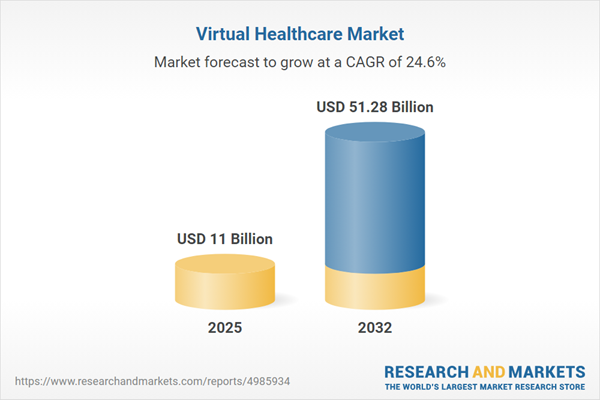Speak directly to the analyst to clarify any post sales queries you may have.
The virtual healthcare market is rapidly evolving as digital transformation reshapes patient engagement, care delivery, and organizational strategy, presenting new opportunities and challenges for industry leaders seeking to navigate a dynamic health ecosystem.
Market Snapshot: Growth Trajectory of the Virtual Healthcare Market
The Virtual Healthcare Market grew from USD 8.85 billion in 2024 to USD 11 billion in 2025. It is expected to continue growing at a CAGR of 24.55%, reaching USD 51.28 billion by 2032. This trajectory reflects a shift from niche solutions to essential healthcare infrastructure, fueled by rising consumer expectations, advancing technology, and evolving regulations. The market’s acceleration highlights strategic imperatives for decision-makers focused on technology integration, operational agility, and competitive positioning.
Scope & Segmentation: In-Depth Overview of Virtual Healthcare Components and Markets
- Component: Accessories, devices, managed services, professional services, customer relationship management, data analytics, EMR integration, scheduling, and virtual assistants.
- Technology: Mobile health platforms, app stores, proprietary portals, remote patient monitoring solutions, implantables, wearables, store-and-forward capabilities, medical imaging, patient data transmission, and video conferencing for both group and one-on-one consultations.
- Teleconsultation: Audio and video formats, including group and individual sessions.
- Telemonitoring: Chronic disease management (cardiac and diabetes), general wellness monitoring, and post-operative care.
- Delivery Mode: Cloud-based (private and public cloud) and on-premise models.
- End User: Direct-to-consumer platforms, home users, payers, clinics, and hospitals.
- Region: Americas (United States, Canada, Mexico, Brazil, Argentina, Chile, Colombia, Peru), Europe (United Kingdom, Germany, France, Russia, Italy, Spain, Netherlands, Sweden, Poland, Switzerland), Middle East (UAE, Saudi Arabia, Qatar, Turkey, Israel), Africa (South Africa, Nigeria, Egypt, Kenya), and Asia-Pacific (China, India, Japan, Australia, South Korea, Indonesia, Thailand, Malaysia, Singapore, Taiwan).
- Key Companies: Teladoc Health, Ping An Healthcare and Technology, American Well, Doctor on Demand, Optum, Babylon Holdings, MDLIVE, Cigna, 98point6, and CVS Health.
Primary Keyword: Virtual Healthcare Market
Key Takeaways: Strategic Insights for Senior Leaders
- Digital transformation is driving a comprehensive shift from isolated teleconsultations to integrated virtual care platforms, blending AI, device connectivity, and actionable analytics into end-to-end healthcare solutions.
- Regulatory evolution, including updated reimbursement policies and data exchange standards, is advancing market adoption and highlighting the need for compliance-led strategies.
- Industry competition is intensifying as traditional providers, technology innovators, and payers pursue strategic partnerships, mergers, and acquisitions to expand reach and accelerate digital capability development.
- Cloud-based and hybrid delivery modes are enabling scalable, secure, and convenient care pathways, supporting both individual and institutional users across diverse regional environments.
- Patient engagement, interoperability, and value-based care integration are emerging as differentiators for healthcare organizations seeking to balance experience with operational efficiency.
Tariff Impact: Navigating Supply Chain and Innovation Pressures
New United States tariffs on relevant medical devices and software are altering the virtual healthcare supply chain, increasing production costs and prompting strategic adaptation. Vendors are diversifying sourcing, reevaluating supplier agreements, and accelerating adoption of cloud-based models to mitigate hardware cost pressures. Organizations with adaptable procurement strategies and diversified partnerships are better positioned to manage ongoing risks and sustain delivery of virtual services.
Methodology & Data Sources
This analysis uses a robust methodology, combining expert interviews, regulatory and industry publications, and triangulated validation to ensure data reliability and context. Segmentation employs product, technology, care modality, delivery mode, end user, and geographic indicators. Impact assessments incorporate primary and secondary data, supplemented by feedback from subject-matter experts at each stage.
Why This Report Matters
- Enables senior decision-makers to benchmark strategic options for technology adoption, portfolio expansion, and digital infrastructure investment.
- Supports proactive scenario planning, risk mitigation, and resource allocation for navigating evolving regulatory, innovation, and market environments.
- Delivers actionable guidance for forging partnerships, enhancing patient engagement, and adapting to rapid shifts in the virtual healthcare marketplace.
Conclusion
The virtual healthcare market continues to reshape patient care, operational models, and ecosystem collaboration. Decision-makers equipped with targeted insights can confidently position their organizations for resilience, growth, and innovation in a rapidly advancing landscape.
Additional Product Information:
- Purchase of this report includes 1 year online access with quarterly updates.
- This report can be updated on request. Please contact our Customer Experience team using the Ask a Question widget on our website.
Table of Contents
3. Executive Summary
4. Market Overview
7. Cumulative Impact of Artificial Intelligence 2025
Companies Mentioned
The companies profiled in this Virtual Healthcare market report include:- Teladoc Health, Inc.
- Ping An Healthcare and Technology Company Limited
- American Well Corporation
- Doctor on Demand, Inc.
- Optum, Inc.
- Babylon Holdings Limited
- MDLIVE, Inc.
- Cigna Corporation
- 98point6, Inc.
- CVS Health Corporation
Table Information
| Report Attribute | Details |
|---|---|
| No. of Pages | 198 |
| Published | October 2025 |
| Forecast Period | 2025 - 2032 |
| Estimated Market Value ( USD | $ 11 Billion |
| Forecasted Market Value ( USD | $ 51.28 Billion |
| Compound Annual Growth Rate | 24.5% |
| Regions Covered | Global |
| No. of Companies Mentioned | 11 |









